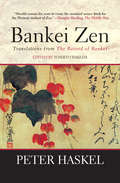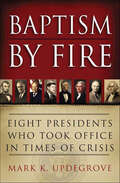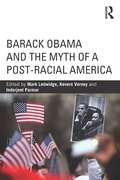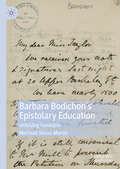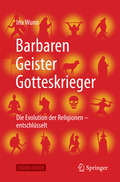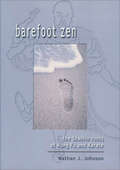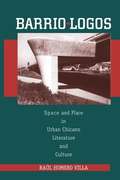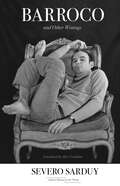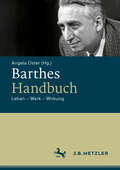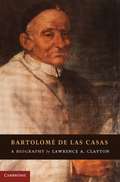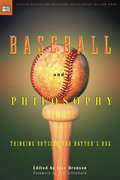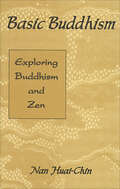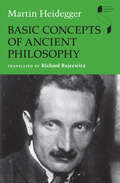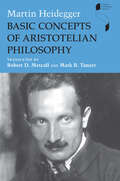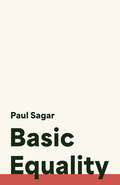- Table View
- List View
Bankei Zen: Translations from The Record of Bankei
by Yoshito HakedaThe teachings of the groundbreaking Buddhist Zen Master: “Should remain for years to come the standard source book for the Western student of Zen” (Douglas Harding, The Middle Way). The eccentric Bankei (1622–1693) has long been an underground hero in the world of Zen. At a time when Zen was becoming overly formalized in Japan, he stressed its relevance to everyday life, insisting on the importance of naturalness and spontaneity. This volume presents his teachings—as refreshing and iconoclastic today as they were three hundred years ago—in a fluent translation by Peter Haskel, accompanied by a vivid account of Bankei’s life and times, illustrations, and extensive notes for the scholar. “Mr. Haskel has furnished us with an accurate and polished translation that fully captures the lively colloquial style of the original. The late Professor Hakeda has rendered invaluable assistance in resolving many linguistic problems and in furnishing important insights into the text itself.” —Philip Yampolsky “A splendid record of a dramatically different Zen master.” —Huston Smith “Bankei Zen has given us the essence of Bankei’s unique teaching . . . one which seems particularly appropriate to our time.” —Nancy Wilson Ross
Baptism by Fire: Eight Presidents Who Took Office in Times of Crisis
by Mark K. UpdegroveAmericans have long been defined by how they face adversity. This is perhaps nowhere more evident than in how the nation's chief executive has tackled myriad issues upon entering the White House. The ways that U.S. presidents handle the vast responsibilities of the Oval Office determine the fate of the nation---and, in many cases, the fate of the world.In this fascinating narrative, presidential historian Mark Updegrove looks at eight U.S. presidents who inherited unprecedented crises immediately upon assuming the reigns of power. George Washington led a fragile and fledgling nation while defining the very role of the presidency. When Thomas Jefferson entered the White House, he faced a nation bitterly divided by a two-party schism far more severe than anything encountered today. John Tyler stepped into the office of the presidency during the constitutional crisis left by the first death of a sitting president. Abraham Lincoln inherited a divided nation on the brink of war. Franklin D. Roosevelt sought to quell America's fears during the depths of the Great Depression. His successor, Harry S. Truman, was sworn in as commander in chief at the close of World War II, and John F. Kennedy stepped into the increasingly heated atmosphere of the cold war. In the wake of Watergate, the first unelected president, Gerald R. Ford, aimed to end America's "long national nightmare."As the forty-fourth president takes office, Updegrove presents a timely look at these chief executives and the challenges they faced. In examining the ways in which presidents have addressed crises, Baptism by Fire illustrates the importance of character in leadership—and in the resilience of America itself.
Barack Obama and the Myth of a Post-Racial America: Barack Obama And The Myth Of A Post-racial America (Routledge Series on Identity Politics)
by Inderjeet Parmar Kevern Verney Mark LedwidgeThe 2008 presidential election was celebrated around the world as a seminal moment in U.S. political and racial history. White liberals and other progressives framed the election through the prism of change, while previously acknowledged demographic changes were hastily heralded as the dawn of a "post-racial" America. However, by 2011, much of the post-election idealism had dissipated in the wake of an on-going economic and financial crisis, escalating wars in Afghanistan and Libya, and the rise of the right-wing Tea Party movement. By placing Obama in the historical context of U.S. race relations, this volume interrogates the idealized and progressive view of American society advanced by much of the mainstream literature on Obama. Barack Obama and the Myth of a Post-Racial America takes a careful look at the historical, cultural and political dimensions of race in the United States, using an interdisciplinary analysis that incorporates approaches from history, political science, and sociology. Each chapter addresses controversial issues such as whether Obama can be considered an African-American president, whether his presidency actually delivered the kind of deep-rooted changes that were initially prophesised, and whether Obama has abandoned his core African-American constituency in favour of projecting a race-neutral approach designed to maintain centrist support. Through cutting edge, critically informed, and cross-disciplinary analyses, this collection directly addresses the dimensions of race in American society through the lens of Obama’s election and presidency.
Barbara Bodichon’s Epistolary Education: Unfolding Feminism
by Meritxell Simon-Martin"This book brings together feminist histories in education with an innovative approach to epistolary narrative analytics. In deploying the notion of the epistolary bildung the author rigorously and eloquently shows how the correspondence of Barbara Bodichon can shed fresh light in a range of personal problems and public issues in women’s lives, which remain relevant today"- Maria Tamboukou, Professor of Feminist Studies, University of East London, UKThis book assesses Barbara Bodichon’s significance in the history of the women’s movement in Britain by elaborating a conceptualisation of letters as sources of feminist development. Bodichon was the leader of the first women’s suffrage committee in England, which collected 1,500 signatures in favour of the female vote – a petition presented in the House of Commons by sympathising MPs to support the amendment of the 1867 Reform Bill. This book explores the significance of letter-exchange in Barbara Bodichon’s feminist becoming as she managed to mobilize partisans and secure signatures by means of chains of friendship letters spreading across the country. For letters functioned as platforms where, concomitantly to her making sense of her experiential input, Bodichon adopted, redefined and challenged circulating discourses – transforming them in the process and hence contributing to the production of feminist knowledge, intersubjectively and collaboratively in dialogue with her addressees. At the crossroads of history of feminism, gender history and history of women’s education, this book explores the significance of letter-exchange in Bodichon’s development into one of the galvanizing figures of the women’s rights movement in Victorian England.
Barbaren, Geister, Gotteskrieger: Die Evolution der Religionen – entschlüsselt
by Ina WunnEin neuer Blick auf die Entwicklung der Religionen In diesem Buch geht es um die Evolution der Religionen, also um die Frage, wie und warum sich Religionen im Laufe ihrer geschichtlichen Entwicklung ver#65533;ndern und welche Gesetzm#65533;#65533;igkeiten diesen Ver#65533;nderungen zugrunde liegen. Die Autorin schildert zun#65533;chst, wie der Evolutionsgedanke sowohl in der Biologie als auch in den Geisteswissenschaften Fu#65533; gefasst hat. Dies war eine Zeit eigenwilliger Protagonisten und spannender Kontroversen, die lebhaft vor das Auge des Lesers treten. Das Buch geht dann der Frage nach, was Evolution im Bereich der Religion eigentlich bedeutet und welche Faktoren diese religi#65533;se Evolution steuern. Welcher Anpassungswert kommt Religionen zu? Wie spalten sich Religionen auf und entwickeln sich in zunehmender Eigenst#65533;ndigkeit? Gibt es so etwas wie eine Vererbung, eine Stammesgeschichte und eine Systematik der Religionen, #65533;hnlich des Gedankengeb#65533;udes, das die biologische Evolutionstheorie f#65533;r die Entwicklung der Organismenwelt entworfen hat? Am Ende dieses mutigen Buches steht nicht nur eine belastbare Theorie religi#65533;ser Evolution, sondern es wird auch deutlich, welche Umwelt- und sozialen Faktoren die Entwicklung von Religionen heute steuern. In einer Welt, in der das Religi#65533;se mit Macht zur#65533;ckzukehren scheint, d#65533;rfte dieses Werk auch zu einem differenzierteren Blick auf die Vielfalt und Einheit der Religionen beitragen. Die Autorin Ina Wunn ist Professorin f#65533;r Religionswissenschaft an der Leibniz-Universit#65533;t Hannover. Das besondere Interesse der Biologin und Religionswissenschaftlerin gilt dem Ursprung und der Evolution der Religionen.
Barbarism (Continuum Impacts #95)
by Michel Henry Scott DavidsonBarbarism represents a critique, from the perspective of Michel Henry's unique philosophy of life, of the increasing potential of science and technology to destroy the roots of culture and the value of the individual human being. For Henry, barbarism is the result of a devaluation of human life and culture that can be traced back to the spread of quantification, the scientific method and technology over all aspects of modern life. The book develops a compelling critique of capitalism, technology and education and provides a powerful insight into the political implications of Henry's work. It also opens up a new dialogue with other influential cultural critics, such as Marx, Husserl, and Heidegger. <p><p> First published in French in 1987, Barbarism aroused great interest as well as virulent criticism. Today the book reveals what for Henry is a cruel reality: the tragic feeling of powerlessness experienced by the cultured person. Above all he argues for the importance of returning to philosophy in order to analyse the root causes of barbarism in our world.
Bardic Destinies: A Comparative Study of European Poetic and Indian Kavya-Itihasa Tradition (Critical Humanities Across Cultures)
by Krishna R. KanchithThis volume critically explores the cultural significance and fate of the “literary” in the European and the Indian traditions as it traces the history of the reception of works that have had a deep hold on the lives and sensibilities of people across time and cultures. The book grapples with three major concepts in the humanities—the literary, the philosophical/theological and the historical. It looks at Homer’s reception by Plato; Virgil’s reception by Christianity; the many responses that The Mahabharata has received over centuries and across cultures in India; and the reception of Kumaravyasa’s Kumaravyasabharata, among other works, and analyses the understanding of truth, time and history that influence the reading of these works in different times and cultural contexts. Part of the Critical Humanities across Cultures series, this book will be useful for scholars and researchers of philosophy, literature, history, comparative literature, cultural studies and post-colonial studies.
Bare Facts and Naked Truths: A New Correspondence Theory of Truth
by George EnglebretsenThe very idea of truth as a substantial and meaningful concept has been under attack recently from advocates of New Age and postmodern theories. In this book Englebretsen defends the notions of truth and objectivity as key to the scientific view of the natural world and presents an original defence of the 'commonsense' correspondence theory of truth. Englebretsen's approach overcomes the traditional difficulties of correspondence theories of truth with providing adequate and convincing accounts of truth-bearers, truth-makers and the correspondence relation between them by taking truth-bearers to be propositions and facts as constitutive properties of the world. This accessibly written book surveys all of the major competing theories of truth (coherence, pragmatic, redundancy, semantic, deflationary, disquotational, minimalist) before formulating the new defence of the correspondence theory and then exploring the consequences of the theory for issues in epistemology and ontology. The book concludes by showing how the idea of 'propositional depth' can be used to dissolve the Liar paradoxes.
Barefoot Zen: The Shaolin Roots of Kung Fu and Karate
by Nathan J. JohnsonJohnson makes the Shaolin way legacy accessible to all, releasing the art from the clutches of popular images and painful concerns about self-defense.Barefoot Zen is a brave new approach to the martial arts, which clearly demonstrates that the traditional movements of both Kung Fu and Karate, contained in the solo choreographed sequences of movements known as forms (or kata), grew out of the spiritual practices of the Shaolin order of Buddhist monks and nuns. Nathan Johnson explains that this mystical and non-violent teaching is a profound and beautiful expression of Chan (Zen) Buddhism and its pursuit of wisdom, peace, and enlightenment. Contrary to popular assumption, he contends that it was never intended to be an actual means of self-defense. Barefoot Zen bridges the gap between Kung Fu and Karate, and reveals their common origin through the disclosure of vital research material on three of the world’s most important Karate kata.Part I explains the spiritual disciplines that contributed to what we know as the martial arts. Part II explains the creation of the art along with practical instruction for performing kata. Part III explains the formation of many of the world’s Kung Fu styles.We learn that the original “empty hand art” was used as a method of kinetic meditation between pairs and was designed as a practical tool to assist practitioners in transcending the fear and insecurity of everyday living. The legendary courage of the Shaolin (Chan/Zen) order was not developed by fighting with enemies, but by not fighting!The Shaolin teaching was designed to free us from fear, the only true enemy.
Baroque Naturalism in Benjamin and Deleuze: The Art of Least Distances
by Tim FlanaganThis book, itself a study of two books on the Baroque, proposes a pair of related theses: one interpretive, the other argumentative. The first, enveloped in the second, holds that the significance of allegory Gilles Deleuze recognized in Walter Benjamin’s 1928 monograph on seventeenth century drama is itself attested in key aspects of Kantian, Leibnizian, and Platonic philosophy (to wit, in the respective forms by which thought is phrased, predicated, and proposed).The second, enveloping the first, is a literalist claim about predication itself – namely, that the aesthetics of agitation and hallucination so emblematic of the Baroque sensibility (as attested in its emblem-books) adduces an avowedly metaphysical ‘naturalism’ in which thought is replete with predicates. Oriented by Barbara Cassin’s development of the concerted sense in which homonyms are critically distinct from synonyms, the philosophical claim here is that ‘the Baroque’ names the intervallic [διαστηµατική] relation that thought establishes between things. On this account, any subject finds its unity in a concerted state of disquiet – a state-rempli in which, phenomenologically speaking, experience comprises as much seeing as reading (as St Jerome encountering Origen’s Hexapla).
Baroque, Venice, Theatre, Philosophy (Performance Philosophy)
by Will DaddarioThis book theorizes the baroque as neither a time period nor an artistic style but as a collection of bodily practices developed from clashes between governmental discipline and artistic excess, moving between the dramaturgy of Jesuit spiritual exercises, the political theatre-making of Angelo Beolco (aka Ruzzante), and the civic governance of the Venetian Republic at a time of great tumult. The manuscript assembles plays seldom read or viewed by English-speaking audiences, archival materials from three Venetian archives, and several secondary sources on baroque, Renaissance, and early modern epistemology in order to forward and argument for understanding the baroque as a gathering of social practices. Such a rethinking of the baroque aims to complement the already lively studies of neo-baroque aesthetics and ethics emerging in contemporary scholarship on (for example) Latin American political art.
Barrio-Logos: Space and Place in Urban Chicano Literature and Culture
by Villa Raúl HomeroStruggles over space and resistance to geographic displacement gave birth to much of Chicano history and culture. In this pathfinding book, Raúl Villa explores how California Chicano/a activists, journalists, writers, artists, and musicians have used expressive culture to oppose the community-destroying forces of urban renewal programs and massive freeway development and to create and defend a sense of Chicano place-identity.
Barroco and Other Writings (Cultural Memory in the Present)
by Severo SarduySevero Sarduy was among the most important figures in twentieth-century Latin American fiction and a major representative of the literary tendency to which he gave the name Neobaroque. While most of Sarduy's literary work is available in English, his theoretical writings have largely remained untranslated. This volume—presenting Sarduy's central theoretical contribution, Barroco (1974), alongside other related works—remedies that oversight. Barroco marks a watershed in postwar thought on the Baroque, both in French post-structuralism and in the Latin American context. Sarduy traces a double history, reading events in the history of science alongside developments in the history of art, architecture, and literature. What emerges is a theory of the Baroque as decentering and displacement, as supplement and excess, a theory capacious enough to account for the old European Baroque as well as its queer, Latin American and global futures. In addition to Barroco, this volume includes texts spanning Sarduy's career, from 1960s essays published originally in Tel Quel to late works from the 1980s and '90s. It thus offers a complete picture of Sarduy's thinking on the Baroque.
Barth's Ontology of Sin and Grace: Variations on a Theme of Augustine (Barth Studies)
by Shao Kai TsengIn recent Barth studies it has been argued that a key to understanding the theologian’s opposition to natural theology is his rejection of substantialist ontology. While this is true to an extent, this book argues that it is a mistake to see Barth’s ‘actualistic ontology’ as diametrically opposed to traditional substantialism. Probing into Barth’s soteriological hamartiology in Church Dogmatics, III-IV, a largely neglected aspect of these volumes in recent debates on his understanding of being and act, it shows how his descriptions of sin, nature, and grace shed light on the precise manners in which his actualistic ontology operates on both a substance grammar of being and a process grammar of becoming, while rejecting the metaphysics underlying both grammars. Looking at issues such as original sin, universal salvation and human will, Barth is shown to be radically redefining the relationship between humans, their actions and the divine. This book argues that human ‘nature’ is the total determination of the human being ‘from above’ by God’s grace in Christ, while the existential dimension of the human being is also totally determined ‘from below’ by the Adamic history of sin. This serves to demonstrate Barth’s endeavours in eliminating the vestiges of natural theology within the Western tradition handed down from Augustine. By exploring these issues this book offers a fresh insight into Barth’s relationship with his theological forbears. As such, it will be vital reading for any scholar of Barth studies, the problem of evil, and theological ontology.
Barthes-Handbuch: Leben – Werk – Wirkung
by Angela OsterRoland Barthes zählt zu den wichtigsten Intellektuellen des 20. Jahrhunderts. Sowohl die zeitgenössische Brisanz als auch die zukunftsweisende Prägnanz seiner Texte bewirken eine anhaltende Faszination. Als akademischer Semiotiker und literarischer Essayist wird Barthes mit „Mythen des Alltags“ berühmt und prägt die gesellschaftliche Diskussion mit kritischen Beiträgen zu Kunst und Kultur, Politik und Wissenschaft. Die Welt ist für ihn ein lebendiger Text, der unentwegt gelesen, entziffert und interpretiert werden muss. Barthesʼ unverwechselbares Sprachdenken stellt keine abstrakte Tätigkeit dar, sondern beruft sich auf die Lust am Text. Lesen und Schreiben sind existenzielle Ereignisse, denen Barthes auch in anderen Künsten (Malerei, Musik), Medien (Theater, Film) und Fachgebieten (Philosophie, Soziologie, Psychologie) nachgeht. Erstmalig erschließt ein Handbuch das umfangreiche Werk Barthesʼ in seinen vielfältigen Facetten: kulturgeschichtliche Kontexte, Forschungstendenzen und internationale Wirkungsgeschichte. Die Übersichtskapitel zu den theoretischen, journalistischen und essayistischen Schriften werden von systematischen Beiträgen flankiert, die Querbezüge von der Atopie bis zur Tragödie eröffnen.
Bartolomé de las Casas
by Lawrence A. ClaytonThe Dominican priest Bartolomé de las Casas (1485-1566) was a prominent chronicler of the early Spanish conquest of the Americas, a noted protector of the American Indians and arguably the most significant figure in the early Spanish Empire after Christopher Columbus. Following an epiphany in 1514, Las Casas fought the Spanish control of the Indies for the rest of his life, writing vividly about the brutality of the Spanish conquistadors. Once a settler and exploiter of the American Indians, he became their defender, breaking ground for the modern human rights movement. Las Casas brought his understanding of Christian scripture to the forefront in his defense of the Indians, challenging the premise that the Indians of the New World were any less civilized or capable of practising Christianity than Europeans. Bartolomé de las Casas: A Biography is the first major English-language and scholarly biography of Las Casas' life in a generation.
Baruch Spinoza's Ethics (The Macat Library)
by Andreas Vrahimis Gary SlaterBaruch Spinoza’s Ethics is a dense masterpiece of sustained argumentative reasoning. It earned its place as one of the most important and influential books in Western philosophy by virtue of its uncompromisingly direct arguments about the nature of God, the universe, free will, and human morals. <P><P>Though it remains one of the densest and most challenging texts in the entire canon of Western philosophy, Ethics is also famous for Spinoza’s unique approach to ordering and constructing its arguments. As its full title – Ethics, Demonstrated in Geometrical Order – suggests, Spinoza decided to use the rigorous format of mathematical-style propositions to lay out his arguments, just as the Ancient Greek mathematician Euclid had used geometrical propositions to lay out the basic rules of geometry. <P><P>In choosing such a systematic method, Spinoza’s masterwork shows the crucial aspects of good reasoning skills being employed at the highest level. The key use of reasoning is the production of an argument that is well-organised, supports its conclusions and proceeds logically towards its end. Just as a mathematician might demonstrate a geometrical proof, Spinoza sought to lay out a comprehensive philosophy for human existence – an attempt that has influenced generations of philosophers since.
Bas van Fraassen's Approach to Representation and Models in Science (Synthese Library #368)
by Wenceslao J. GonzalezThis book analyzes Bas van Fraassen's characterization of representation and models in science. In this regard, it presents the philosophical coordinates of his approach and pays attention to his structural empiricism as a framework for his views on scientific representations and models. These are developed here through two new contributions made by van Fraassen. In addition, there are analyses of the relation between models and reality in his approach, where the complexity of this conception is considered in detail. Furthermore, there is an examination of scientific explanation and epistemic values judgments. This volume includes a wealth of bibliographical information on his philosophy and relevant philosophical issues. Bas van Fraassen is a key figure in contemporary philosophy of science, as the prestigious Hempel Award shows. His views on scientific representation offer new ideas on how it should be characterized, and his conception of models shows a novelty that goes beyond other empiricists' approaches of recent times. Both aspects -- the characterization of scientific representation and the conception of models in science -- are part of a deliberate attempt to forge a "structural empiricism," an alternative to structural realism based on an elaborated version of empiricism.
Baseball and Philosophy
by William Irwin Bill Littlefield Eric BronsonBaseball and Philosophy brings together two high-powered pastimes: the sport of baseball and the academic discipline of philosophy. Eric Bronson asked eighteen young professors to provide their profound analysis of some aspect of baseball. The result offers surprisingly deep insights into this most American of games.The contributors include many of the leading voices in the burgeoning new field of philosophy of sport, plus a few other talented philosophers with a personal interest in baseball. A few of the contributors are also drawn from academic areas outside philosophy: statistics, law, and history.This volume gives the thoughtful baseball fan substancial material to think more deeply about. What moral issues are raised by the Intentional Walk? Do teams sometimes benefit from the self-interested behavior of their individual members? How can Zen be applied to hitting? Is it ethical to employ deception in sports? Can a game be defined by its written rules or are there also other constraints? What can the U.S. Supreme Court learn from umpiring? Why should baseball be the only industry exempt from antitrust laws? What part does luck play in any game of skill?
Basic Buddhism: Exploring Buddhism and Zen
by Nan Huai-ChinFrom a Chinese religious scholar, the history of Buddhism from its beginnings in sixth-century India to twentieth-century global practices.Nan Huai Chin, a learned representative of the Chinese Buddhist tradition, explores the many different schools of Buddhism and the many stories surrounding the life of Buddha. He explains various philosophical trends in Buddhism and the aspects it has taken on throughout Asia, Europe, and America. For a solid understanding of Buddhism, this book is indispensable reading. With index.
Basic Concepts of Ancient Philosophy (Studies in Continental Thought)
by Martin Heidegger Richard RojcewiczBasic Concepts of Ancient Philosophy presents a lecture course given by Martin Heidegger in 1926 at the University of Marburg. First published in German as volume 22 of the collected works, the book provides Heidegger's most systematic history of Ancient philosophy beginning with Thales and ending with Aristotle. In this lecture, which coincides with the completion of his most important work, Being and Time, Heidegger is working out a way to sharply differentiate between beings and Being. Richard Rojcewicz's clear and accurate translation offers English-speaking readers valuable insight into Heidegger's views on Ancient thought and concepts such as principle, cause, nature, unity, multiplicity, Logos, truth, science, soul, category, and motion.
Basic Concepts of Aristotelian Philosophy (Studies in Continental Thought)
by Martin HeideggerThis volume presents Heidegger’s 1924 Marburg lectures which lay the intellectual groundwork for his magnum opus, Being and Time.Here are the seeds of the ideas that would become Heidegger’s unique and highly influential phenomenology. Heidegger interprets Aristotle’s Rhetoric and looks closely at the Greek notion of pathos. These lectures offer special insight into the development of his concepts of care and concern, being-at-hand, being-in-the-world, and attunement, which were later elaborated in Being and Time.Available in English for the first time, these lectures make a significant contribution to ancient philosophy, Aristotle studies, Continental philosophy, and phenomenology.
Basic Desert, Reactive Attitudes and Free Will
by Maureen Sie and Derk PereboomBasic Desert, Reactive Attitudes and Free Will addresses the issue of whether we can make sense of the widespread conviction that we are morally responsible beings. It focuses on the claim that we deserve to be blamed and punished for our immoral actions, and how this claim can be justified given the philosophical and scientific reasons to believe that we lack the sort of free will required for this sort of desert. Contributions to the book distinguish between, and explore, two clusters of questions. The first asks what it is to deserve to be harmed or benefitted. What are the bases for desert – actions, good character, bad character, the omission of good character traits? The second cluster explores the disagreement between compatabilists and incompatibilists surrounding the nature of desert. Do we deserve to be harmed, benefitted, or judged, even if we lack the ability to act differently, and if we do not, what effect does this have on our everyday actions? Taken in full, this book sheds light on the notion of desert implicated in our practice of holding each other morally responsible. This book was originally published as a special issue of Philosophical Explorations.
Basic Equality
by Paul SagarAn innovative argument that vindicates our normative commitment to basic equality, synthesising philosophy, history, and psychologyWhat makes human beings one another&’s equals? That we are "basic equals" has become a bedrock assumption in Western moral and political philosophy. And yet establishing why we ought to believe this claim has proved fiendishly difficult, floundering in the face of the many inequalities that characterise the human condition. In this provocative work, Paul Sagar offers a novel approach to explaining and justifying basic equality. Rather than attempting to find an independent foundation for basic equality, he argues, we should instead come to see our commitment to this idea as the result of the practice of treating others as equals. Moreover, he continues, it is not enough to grapple with the problem through philosophy alone—by just thinking very hard, in our armchairs; we must draw insights from history and psychology as well.Sagar writes that, as things stand, there appear to be no good arguments for believing in the truth of basic equality. Indeed, for much of Western intellectual history and social practice, basic inequality has been the default position. How is it then, Sagar asks, that in Western societies, in a period of less than a century, basic equality emerged as the dominant view? Sagar approaches this not as a mere philosophical puzzle, but as a dramatic historical development. In so doing, he shows us what is at stake when human beings treat one another as equals just because they are human beings.
Basic Ethics: An Applied Philosophical Approach (Basic Ethics In Action Ser.)
by Michael BoylanBasic Ethics presents for a wide range of students and other interested readers the questions raised in thinking about ethical problems, the answers offered by moral philosophy, and the means to better integrate into both the reader’s world and personal life. It takes up what the author calls a "worldview theory," which shows readers how to begin with the values and understanding of the world that they already possess in order to transition from there to new levels of increasing ethical awareness. Updates to the third edition include the more thorough integration of feminist ethics into the principal theoretical traditions, a new chapter on the ethical responsibility to be well informed of current events, expanded coverage of human rights, and additional opportunities on how to use ethical reasoning in thinking about one’s own life and about public policy. Key Features: Links personal values to a philosophical treatment of the major ethical theories Presents ethics in the context of social/political issues that face our nation and the world Challenges the student to react to the presented material through critical exercises that may be used as weekly assignments and can form the basis of class discussion and evaluation. Engages the student to think about underlying issues first (in the basic questions) before presenting the most popular solutions (in the basic answers) Invites the reader to make up her own mind on how to formulate an ethical theory that will help her in her own life Offers a 16-chapter format to fit into most college-semester calendars Presents an overall structure that establishes foundational problems in ethical theory in the first section of the book that are variously addressed by the different ethical theories in the second section of the book Highlights key terms to help the reader grapple with issues raised (which are reviewed and defined in a final Glossary) Includes a final chapter designed to help students comprehend the book in its entirety. Updates to the Third Edition: Highlights new research on human rights and their relevance to ethical thinking and contemporary moral issues Integrates feminist ethics into the principal theoretical traditions: virtue ethics, ethical intuitionism, and some versions of deontology Provides new coverage of "fake news" and the moral responsibility to be well and accurately informed of current events Expands opportunities to use ethical reasoning in thinking about one’s own life and about public policy.
